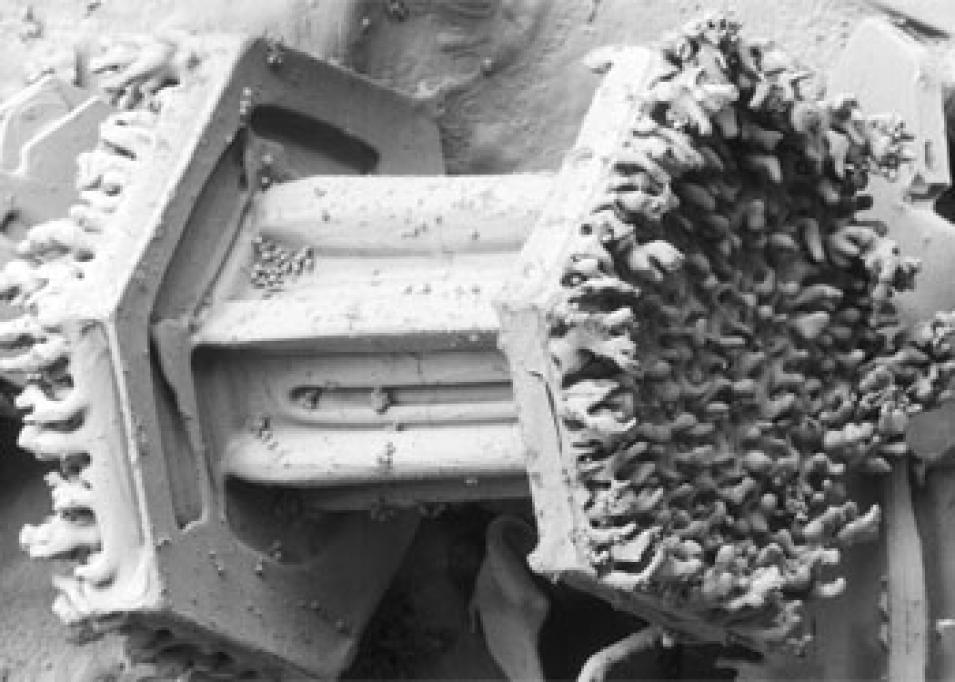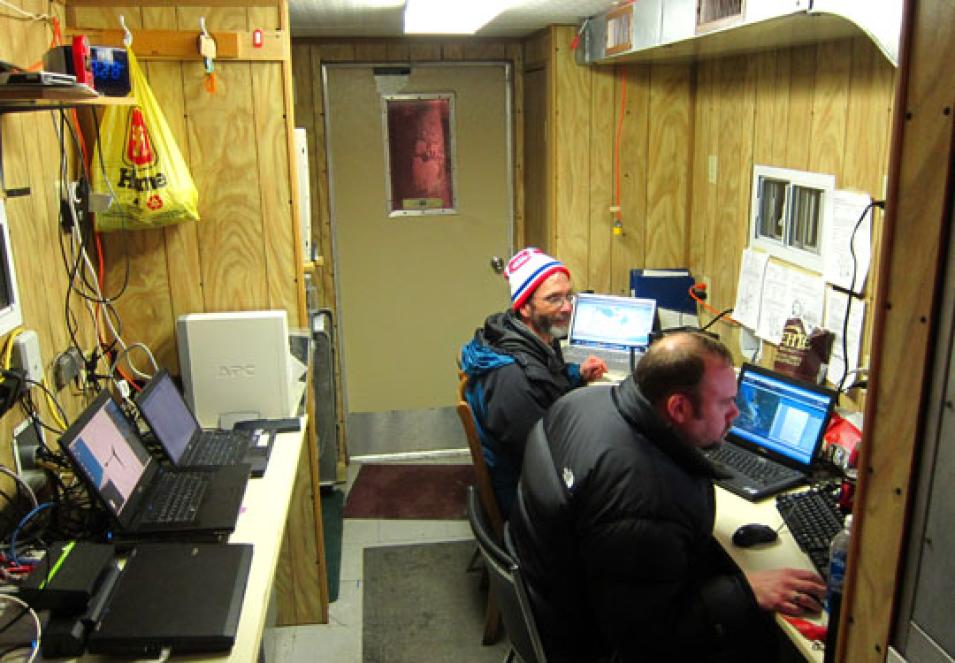As the storm approached Egbert, three aircraft were already en route. NASA's DC-8 airplane flew high above the storm carrying the Airborne Precipitation Radar-2 and the Conical Scanning Millimeter-wave Imaging Radiometer (CoSMIR), instruments similar to those that would fly in space. “The DC-8 is our proxy satellite,” Petersen said. “It collects data that will help us connect what we see from space to what is going on in the storm and on the ground.”
In the snowing clouds, the University of North Dakota’s Citation and the Canadian National Research Council’s Convair flew spirals in and under the storm and dog bone patterns along the snow band. These aircraft flew meteorological sensors and probes that measured snowflake size and water content, as well as temperature and cloud water. On land, an array of twenty instruments measured the physical aspects of the snow. How much did it weigh? How fast did it fall? What kinds of snowflake shapes were falling and how much water did they hold?
“We are building this column of understanding of snowfall and snowfall characteristics from the top of the cloud all the way to the ground,” Gatlin said. The storm was just what they needed to wrap up the campaign. “It was the golden storm,” Gatlin said. “Everything came together at once; all the aircraft flew and all the ground sensors were working and collected a lot of data.”
Like a shaken snow globe
The researchers are on track to use the data to prep the Global Precipitation Mission (GPM) Core Observatory satellite that launches in 2014. The satellite will be the first to recognize and measure snow from space, and do so before snow lands on the ground. “That’s what’s so different about this satellite. We specifically designed it to make global measurements of snow before it hits Earth’s surface,” Skofronick-Jackson said. “Satellites have difficulties measuring snow in mountainous regions. So it’s great to be able to measure snow before you have to deal with these surface features.”
Scientists currently measure snow using snow pillows, platforms on the ground that weigh snow pack. Unfortunately, the snow pillows are sparse, and it is hard to tease out global trends from the data. There are satellites that measure snow cover worldwide but these run into problems when flying over forests. “If the snow lands on the trees or falls through the trees, that affects the satellite’s ability to measure snow,” Skofronick-Jackson said. “The same goes for snowpack that gets a heavy crust of ice on top of it from repeated melting and refreezing.”
The GPM Core Observatory, which will also measure rain, will not identify every single snowflake shape that it sees, but “in a bulk sense, will know whether they are all needles, mostly hexagonal plates, or all dendrites which are the pretty ones you normally see,” Skofronick-Jackson said. It will still take scientists several years to catch up to where rain measurement is right now. “But we are starting that process with this satellite,” she said. “After the field campaign, we re-recognized that snow is a complex process, and being able to understand it and estimate falling snow from spaceborne instruments is going to be a process for several generations of scientists to come.”
References
Molthan, A. L., and W. A. Petersen. 2011. Incorporating ice crystal scattering databases in the simulation of millimeter-wavelength radar reflectivity. Journal of Atmospheric and Oceanic Technology 28, 337–351. doi:10.1175/2010JTECHA1511.1
NASA Global Hydrometeorology Resource Center Distributed Active Archive Center (GHRC DAAC). GPM-GV GCPEx Products. Huntsville, Alabama USA.
Skofronick-Jackson G. M., M.-J. Kim, J. A. Weinman, and D.-E. Chang. 2004. A physical model to determine snowfall over land by microwave radiometry. IEEE Transactions on Geoscience and Remote Sensing 42: 1,047–1,058. doi:10.1109/TGRS.2004.825585
Skofronick-Jackson, G., and B. T. Johnson. 2011. Surface and atmospheric contributions to passive microwave brightness temperatures for falling snow events. Journal of Geophysical Research 116, D02213. doi:10.1029/2010JD014438
Thurai, M., V. N. Bringi, L. D. Carey, P. Gatlin, E. Schultz, W. A. Petersen. 2012. Estimating the accuracy of polarimetric radar–based retrievals of drop-size distribution parameters and rain rate: an application of error variance separation using radar-derived spatial correlations. Journal of Hydrometeorology 13: 1,066–1,079. doi:10.1175/JHM-D-11-070.1
For more information
NASA Global Hydrometeorology Resource Center Distributed Active Archive Center (GHRC DAAC)
NASA Global Precipitation Measurement (GPM) Cold-season Precipitation Experiment
| About the data used |
| Sensor | Various aircraft microphysical probes, thermodynamic sensors, radiometers, profilers, radars, disdrometers, and precipitation gauges |
| Data sets | Airborne Precipitation Radar version 2 (APR-2)
Conical Scanning Millimeter-wave Imaging Radiometer (CoSMIR)
Aircraft mounted particle probes and thermodynamic sensors (UND Citation and CNRC Convair 580)
Dual frequency dual polarimetric Doppler radar (D3R)
Environment Canada C-band dual-polarimetric Doppler radar at King City, Ontario
Advanced Microwave Radiometer for Rain Identification (ADMIRARI)
Centre for Atmospheric Research Experiments (CARE) vertical profiling radiometer and
X-band radar Disdrometers, precipitation gauges and meteorological conditions at each ground site |
| DAAC | NASA Global Hydrometeorology Resource Center Distributed Active Archive Center (GHRC DAAC) |
The photograph in the title graphic shows a close-up view of a snowflake. (Courtesy theharv58/Flickr)



